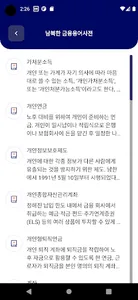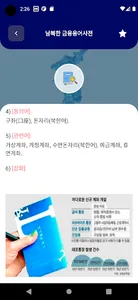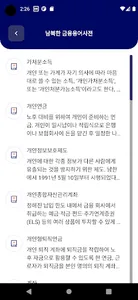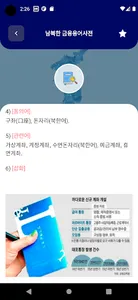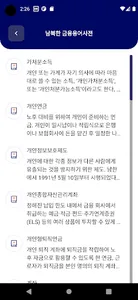Financial terms widely used in South and North Korea were selected as headings, and they went through a process of proofreading, proofreading, and editing.
The headword in the dictionary is ‘Term Selection and Advisory
selected by the team.
South Korean financial terminology experts were in charge of interpreting the meanings of the headwords.
In this dictionary, ‘[rest] I’m 欄’ as the subject of headword-related content.
all. The content of ‘[Rest]’ is mainly about the experiences North Koreans have experienced while living their financial life in South Korea.
is an episode.
The headwords and indexes of the dictionary are arranged in 'Korean alphabetical order', respectively.
The notation in the dictionary was based on the following criteria.
go. The notation is basically ‘Hangul Spelling’ and the ‘Standard Korean Dictionary’ of the National Institute of the Korean Language.
followed However, when citing North Korean data, the notation of North Korean data is the same.
followed with
me. In principle, spaces are written according to the Korean spelling. all
However, technical terms are pasted for the convenience of reading and comprehension.
When citing one material, ‘space spacing in the original text’ was followed as it is.
all. In principle, headwords and explanations are written in Korean, but in some cases, they are written in Chinese characters.
Marked as soon as possible.
The interpretation of the headword was based on the following criteria.
go. The meaning was presented in the form of ‘definition term + additional meaning interpretation’.
me. Since the financial environment of the two Koreas is different, a detailed explanation is added in ‘[Learn more]’.
It was intended to help the Korean people of South and North Korea understand the female heading.
all. To help you understand the headword, suggest ‘[synonym]’, ‘[related word]’, etc.
it was
La. For usage examples, the frequently used ‘idiom phrase (句) expression’ is presented first, and then
In the ‘[Example]’ column, insert the sentences actually used in North and South Korean literature and newspaper materials.
presented.
mind. ‘[Jeonjeon]’ is presented only for documents referenced in the writing. Participation is the following
It was presented according to the formula.
① Paper: Author, year of publication, title of paper, publication journal, publishing institution
② Books: Author, publication year, book title, publication location, publishing institution
Information on headings was presented in the following order.
① Headword ② Explanation of meaning ③ Usage example ④ Synonym
⑤ Related words ⑥ Exhibit ⑦ Illustration ⑧ Author
‘Illustrations’ and ‘photographs’ that clearly show the characteristics of the headword were presented, and the source was revealed.
The appendix included the following.
go. Presenting a pair of inter-Korean financial terms
me. references
The headword in the dictionary is ‘Term Selection and Advisory
selected by the team.
South Korean financial terminology experts were in charge of interpreting the meanings of the headwords.
In this dictionary, ‘[rest] I’m 欄’ as the subject of headword-related content.
all. The content of ‘[Rest]’ is mainly about the experiences North Koreans have experienced while living their financial life in South Korea.
is an episode.
The headwords and indexes of the dictionary are arranged in 'Korean alphabetical order', respectively.
The notation in the dictionary was based on the following criteria.
go. The notation is basically ‘Hangul Spelling’ and the ‘Standard Korean Dictionary’ of the National Institute of the Korean Language.
followed However, when citing North Korean data, the notation of North Korean data is the same.
followed with
me. In principle, spaces are written according to the Korean spelling. all
However, technical terms are pasted for the convenience of reading and comprehension.
When citing one material, ‘space spacing in the original text’ was followed as it is.
all. In principle, headwords and explanations are written in Korean, but in some cases, they are written in Chinese characters.
Marked as soon as possible.
The interpretation of the headword was based on the following criteria.
go. The meaning was presented in the form of ‘definition term + additional meaning interpretation’.
me. Since the financial environment of the two Koreas is different, a detailed explanation is added in ‘[Learn more]’.
It was intended to help the Korean people of South and North Korea understand the female heading.
all. To help you understand the headword, suggest ‘[synonym]’, ‘[related word]’, etc.
it was
La. For usage examples, the frequently used ‘idiom phrase (句) expression’ is presented first, and then
In the ‘[Example]’ column, insert the sentences actually used in North and South Korean literature and newspaper materials.
presented.
mind. ‘[Jeonjeon]’ is presented only for documents referenced in the writing. Participation is the following
It was presented according to the formula.
① Paper: Author, year of publication, title of paper, publication journal, publishing institution
② Books: Author, publication year, book title, publication location, publishing institution
Information on headings was presented in the following order.
① Headword ② Explanation of meaning ③ Usage example ④ Synonym
⑤ Related words ⑥ Exhibit ⑦ Illustration ⑧ Author
‘Illustrations’ and ‘photographs’ that clearly show the characteristics of the headword were presented, and the source was revealed.
The appendix included the following.
go. Presenting a pair of inter-Korean financial terms
me. references
Show More


